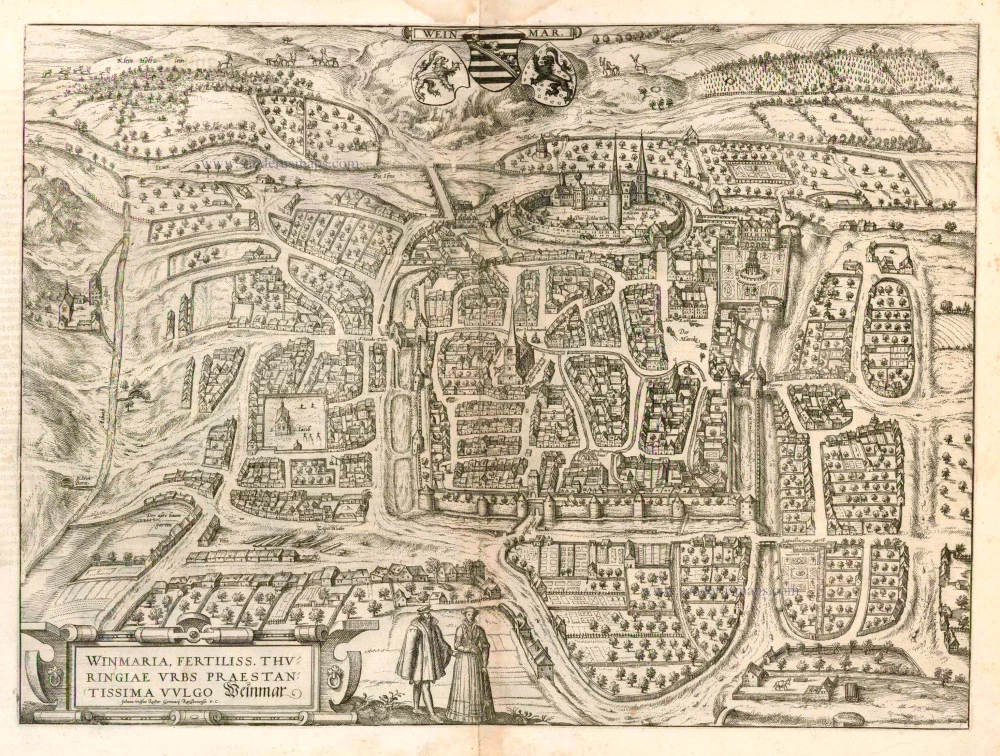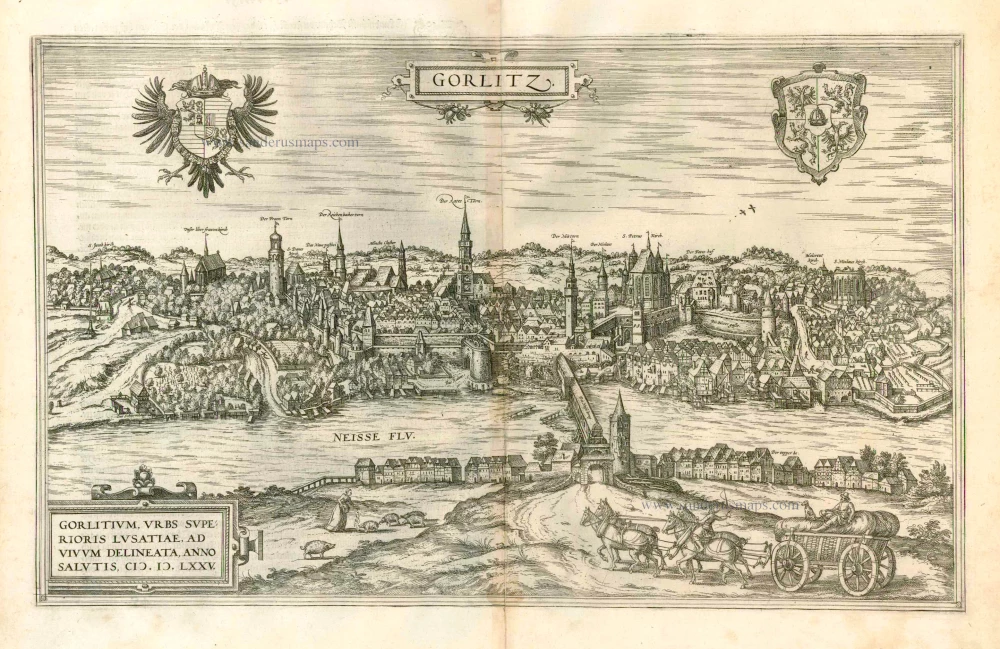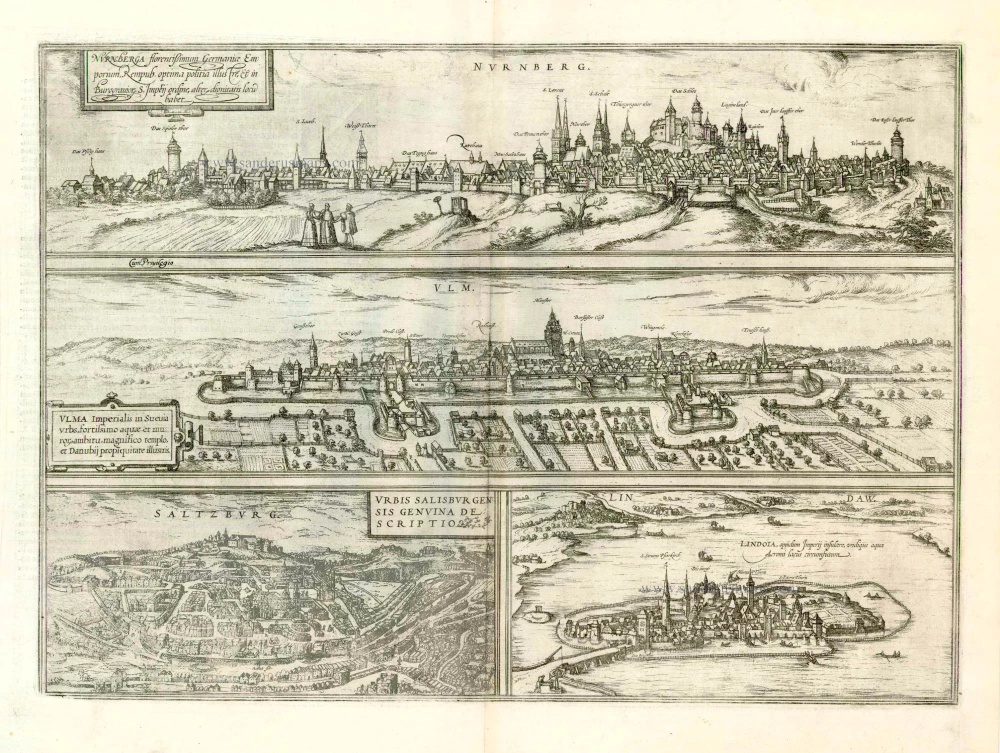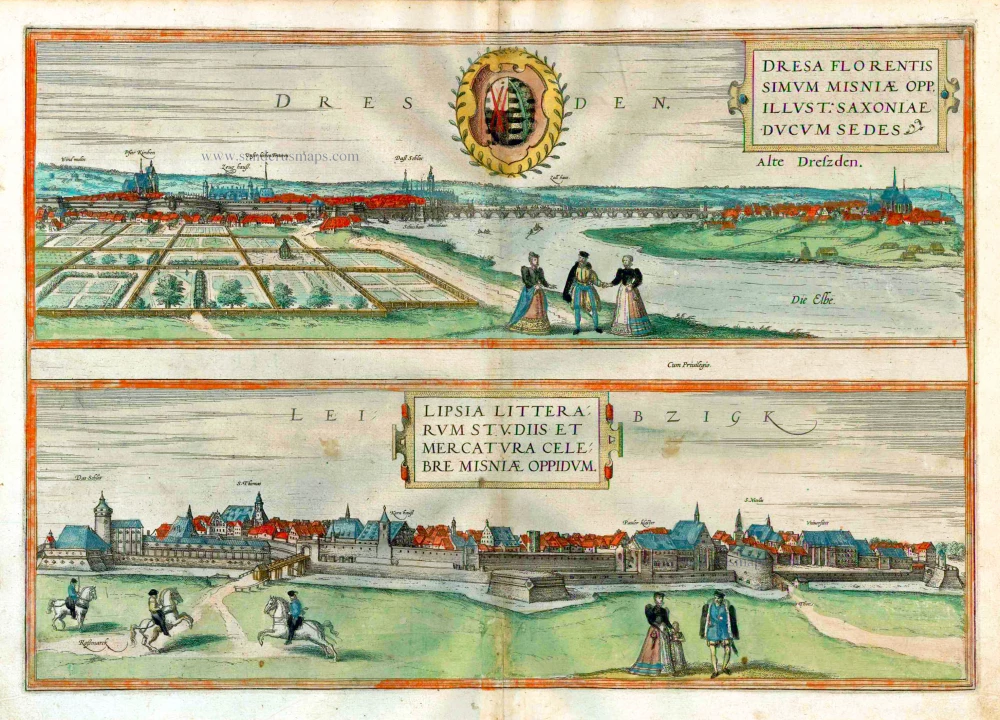Weimar, by Georg Braun and Frans Hogenberg. 1582
TRANSLATION OF CARTOUCHE TEXT: Winmaria is a pre-eminent city in fertile Thuringia, in German Weimar.
COMMENTARY BY BRAUN: "In 1299 and 1404, terrible fires severely harmed Weimar. This misfortune caused great damage, but afterwards, the city was reconstructed and embellished with splendid buildings that now add to its fame and beauty. The imposing palace of the Dukes of Saxony numbers among them [...], with its delightful and well-designed gardens, delicious herbs, and fruit-bearing trees."
This bird's-eye view from the west shows the green city of Weimar in its landscape setting, nestled amongst fertile, rolling fields and meadows beside the Ilm. The original ducal residence is beside the river towards the top of the picture. Hornstein castle, to the right of which Duke John William built the palace with its formal gardens. Visible within the city is the late Gothic church of SS Peter and Paul, today known as the Herderkirche after the theologian and philosopher Johann Gottfried Herder, who worked as a court preacher from 1776 to 1801. In the 14th century (1342-1346), struggles for control over Thuringia resulted in Weimar becoming a fief of the Wettin dynasty. Weimar was granted its charter in 1410; 1424, the city had to be rebuilt after a devasting fire. In 1552, Duke John Frederich the Magnanimous made it the capital of the Duchy of Saxe-Weimar. (Taschen)
Braun G. & Hogenberg F. and the Civitates Orbis Terrarum.
The Civitates Orbis Terrarum, also known as the 'Braun & Hogenberg', is a six-volume town atlas and the most excellent book of town views and plans ever published: 363 engravings, sometimes beautifully coloured. It was one of the best-selling works in the last quarter of the 16th century. Georg Braun, a skilled writer, wrote the text accompanying the plans and views on the verso. Many plates were engraved after the original drawings of a professional artist, Joris Hoefnagel (1542-1600). The first volume was published in Latin in 1572 and the sixth in 1617. Frans Hogenberg, a talented engraver, created the tables for volumes I through IV, and Simon van den Neuwel made those for volumes V and VI. Other contributors were cartographers Daniel Freese and Heinrich Rantzau, who provided valuable geographical information. Works by Jacob van Deventer, Sebastian Münster, and Johannes Stumpf were also used as references. Translations appeared in German and French, making the atlas accessible to a broader audience.
Since its original publication of volume 1 in 1572, the Civitates Orbis Terrarum has left an indelible mark on the history of cartography. Seven more editions followed the first volume in 1575, 1577, 1582, 1588, 1593, 1599, and 1612. Vol.2, initially released in 1575, saw subsequent editions in 1597 and 1612. The subsequent volumes, each a treasure trove of historical insights, graced the world in 1581, 1588, 1593, 1599, and 1606. The German translation of the first volume, a testament to its widespread appeal, debuted in 1574, followed by the French edition in 1575.
Several printers were involved: Theodor Graminaeus, Heinrich von Aich, Gottfried von Kempen, Johannis Sinniger, Bertram Buchholtz, and Peter von Brachel, all of whom worked in Cologne.
Georg Braun (1541-1622)
Georg Braun, the author of the text accompanying the plans and views in the Civitates Orbis Terrarum, was born in Cologne in 1541. After his studies in Cologne, he entered the Jesuit Order as a novice, indicating his commitment to learning and intellectual pursuits. In 1561, he obtained his bachelor's degree; in 1562, he received his Magister Artium, further demonstrating his academic achievements. Although he left the Jesuit Order, he continued his studies in theology, gaining a licentiate in theology. His theological background likely influenced the content and tone of the text in the Civitates Orbis Terrarum, adding a unique perspective to the work.
Frans Hogenberg (1535-1590)
Frans Hogenberg was a Flemish and German painter, engraver, and mapmaker. He was born in Mechelen as the son of Nicolaas Hogenberg.
By the end of the 1560s, Frans Hogenberg was employed upon Abraham Ortelius's Theatrum Orbis Terrarum, published in 1570; he is named an engraver of numerous maps. In 1568, he was banned from Antwerp by the Duke of Alva and travelled to London, where he stayed a few years before emigrating to Cologne. He immediately embarked on his two most important works, the Civitates, published in 1572 and the Geschichtsblätter, which appeared in several series from 1569 until about 1587.
Thanks to large-scale projects like the Geschichtsblätter and the Civitates, Hogenberg's social circumstances improved with each passing year. He died as a wealthy man in Cologne in 1590.
Weinmar - Winmaria, Fertiliss. Thuringiae Urbs Praestantissima vulgo Weinmar
Item Number: 25085 Authenticity Guarantee
Category: Antique maps > Europe > Germany - Cities
Weimar, by Georg Braun and Frans Hogenberg.
Title: Weinmar - Winmaria, Fertiliss. Thuringiae Urbs Praestantissima vulgo Weinmar
Date of the first edition: 1581.
Date of this map: 1582.
Copper engraving, printed on paper.
Size (not including margins): 350 x 475mm (13.78 x 18.7 inches).
Verso: German text.
Condition: Uncoloured, excellent.
Condition Rating: A.
From: Contrafactur und Beschreibung von den vornembsten Stetten der Welt. Liber Tertius. Köln, 1582. (Van der Krogt 4, 41:2.3)
TRANSLATION OF CARTOUCHE TEXT: Winmaria is a pre-eminent city in fertile Thuringia, in German Weimar.
COMMENTARY BY BRAUN: "In 1299 and 1404, terrible fires severely harmed Weimar. This misfortune caused great damage, but afterwards, the city was reconstructed and embellished with splendid buildings that now add to its fame and beauty. The imposing palace of the Dukes of Saxony numbers among them [...], with its delightful and well-designed gardens, delicious herbs, and fruit-bearing trees."
This bird's-eye view from the west shows the green city of Weimar in its landscape setting, nestled amongst fertile, rolling fields and meadows beside the Ilm. The original ducal residence is beside the river towards the top of the picture. Hornstein castle, to the right of which Duke John William built the palace with its formal gardens. Visible within the city is the late Gothic church of SS Peter and Paul, today known as the Herderkirche after the theologian and philosopher Johann Gottfried Herder, who worked as a court preacher from 1776 to 1801. In the 14th century (1342-1346), struggles for control over Thuringia resulted in Weimar becoming a fief of the Wettin dynasty. Weimar was granted its charter in 1410; 1424, the city had to be rebuilt after a devasting fire. In 1552, Duke John Frederich the Magnanimous made it the capital of the Duchy of Saxe-Weimar. (Taschen)
Braun G. & Hogenberg F. and the Civitates Orbis Terrarum.
The Civitates Orbis Terrarum, also known as the 'Braun & Hogenberg', is a six-volume town atlas and the most excellent book of town views and plans ever published: 363 engravings, sometimes beautifully coloured. It was one of the best-selling works in the last quarter of the 16th century. Georg Braun, a skilled writer, wrote the text accompanying the plans and views on the verso. Many plates were engraved after the original drawings of a professional artist, Joris Hoefnagel (1542-1600). The first volume was published in Latin in 1572 and the sixth in 1617. Frans Hogenberg, a talented engraver, created the tables for volumes I through IV, and Simon van den Neuwel made those for volumes V and VI. Other contributors were cartographers Daniel Freese and Heinrich Rantzau, who provided valuable geographical information. Works by Jacob van Deventer, Sebastian Münster, and Johannes Stumpf were also used as references. Translations appeared in German and French, making the atlas accessible to a broader audience.
Since its original publication of volume 1 in 1572, the Civitates Orbis Terrarum has left an indelible mark on the history of cartography. Seven more editions followed the first volume in 1575, 1577, 1582, 1588, 1593, 1599, and 1612. Vol.2, initially released in 1575, saw subsequent editions in 1597 and 1612. The subsequent volumes, each a treasure trove of historical insights, graced the world in 1581, 1588, 1593, 1599, and 1606. The German translation of the first volume, a testament to its widespread appeal, debuted in 1574, followed by the French edition in 1575.
Several printers were involved: Theodor Graminaeus, Heinrich von Aich, Gottfried von Kempen, Johannis Sinniger, Bertram Buchholtz, and Peter von Brachel, all of whom worked in Cologne.
Georg Braun (1541-1622)
Georg Braun, the author of the text accompanying the plans and views in the Civitates Orbis Terrarum, was born in Cologne in 1541. After his studies in Cologne, he entered the Jesuit Order as a novice, indicating his commitment to learning and intellectual pursuits. In 1561, he obtained his bachelor's degree; in 1562, he received his Magister Artium, further demonstrating his academic achievements. Although he left the Jesuit Order, he continued his studies in theology, gaining a licentiate in theology. His theological background likely influenced the content and tone of the text in the Civitates Orbis Terrarum, adding a unique perspective to the work.
Frans Hogenberg (1535-1590)
Frans Hogenberg was a Flemish and German painter, engraver, and mapmaker. He was born in Mechelen as the son of Nicolaas Hogenberg.
By the end of the 1560s, Frans Hogenberg was employed upon Abraham Ortelius's Theatrum Orbis Terrarum, published in 1570; he is named an engraver of numerous maps. In 1568, he was banned from Antwerp by the Duke of Alva and travelled to London, where he stayed a few years before emigrating to Cologne. He immediately embarked on his two most important works, the Civitates, published in 1572 and the Geschichtsblätter, which appeared in several series from 1569 until about 1587.
Thanks to large-scale projects like the Geschichtsblätter and the Civitates, Hogenberg's social circumstances improved with each passing year. He died as a wealthy man in Cologne in 1590.




